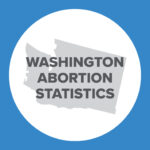Abortion Reporting: Arizona (2021)
Arizona’s 2021 abortion report was published online by the Arizona Department of Health Services in December 2022.
Statistics and Changes in Arizona Abortions, 2020-2021

In 2021, there were 13,998 abortions reported in Arizona, an increase of 5.5 percent from 2020. Abortions performed on Arizona residents also increased by 5.4 percent, while chemical abortions on state residents increased by 1.5 percent (Fig. 1). The Charlotte Lozier Institute (CLI) estimates that Arizona’s state abortion rate was 10.0 abortions per 1,000 women ages 15 to 44 (Fig. 2).
State Report Summary
Resident Demographic Data
Of the abortions performed in Arizona in 2021, 13,896 (99 percent) were performed on Arizona residents. Most of the demographic information in the report is for resident abortions only.
Identical to 2020, nine percent of Arizona resident abortions were performed on girls under the age of 20, with two percent on girls ages 17 or younger and seven percent on girls ages 18 and 19. Thirty-one percent of the abortions were obtained by women ages 20 to 24, and 27 percent were performed on women ages 25 to 29. Twenty-nine percent were performed on women in their thirties and four percent were performed on women ages 40 and older. In Arizona, parental consent is required before an abortion may be performed on a minor girl under the age of 18. In 2021, 52 minors filed petitions asking judges to waive the parental consent requirement, of which 51 were granted and one was withdrawn.
Arizona reports race and ethnicity together, and in 2021, 44 percent of Arizona resident abortions were obtained by Hispanic women. Thirty-three percent of the abortions were on non-Hispanic white women, and 12 percent were on African American women. Four percent of Arizona resident abortions were obtained by Asian or Pacific Islander women. Three percent of the abortions were on American Indian women, while two percent were on women of multiple races and another two percent were on women whose race was not reported. Like most other states, the black abortion rate of 19.1 was significantly higher in Arizona than the non-Hispanic white abortion rate of 7.4.
A majority of the abortions for which education was reported were on women with at least 12 years of education: a little under one quarter of the abortions (23 percent) were obtained by women with 12 years of education and virtually the same number were performed on women with 13 to 16 years of education, while five percent of the abortions were on women with 17 years of education or more. In contrast, 10 percent of the abortions were performed on women with fewer than 12 years of education. However, education was not reported for 38 percent of the abortions.
Eighty-five percent of Arizona abortions were performed on unmarried women, while 15 percent were on married women. Sixty-seven percent of the abortions were on women with at least one prior pregnancy. Twenty percent of the abortions were on women with one previous live birth, and 34 percent were on women with two or more, while 44 percent of the abortions were performed on women with no previous live births. Sixty-six percent of Arizona resident abortions were performed on women with no previous abortions, compared to 22 percent on women with one prior abortion and 10 percent on women with two or more abortions. Nineteen percent of Arizona abortions were performed on women who had previously had a miscarriage. The number of previous live births and abortions were not reported for one percent of Arizona resident abortions, while the number of miscarriages was not reported for two percent.
Medical Information
Just over half of the abortions, 52 percent, were performed surgically. Just under half, 48 percent, were chemical abortions, of which the vast majority, 99.2 percent, were induced using mifepristone.
A quarter of Arizona resident abortions occurred at six weeks of gestation or earlier. Thirty-four percent were performed between seven and eight weeks, and 20 percent were performed between nine and 10 weeks of gestation. Eight percent occurred between 11 and 12 weeks, and five percent were performed between 13 and 14 weeks. Four percent were performed between 15 and 16 weeks of gestation, and two percent were performed from 17 to 19 weeks. There were 311 abortions (2.2 percent), up from 238 in 2020, performed at 20 weeks of gestation or later, with 0.6 percent at 20 weeks and 1.6 percent at or after 21 weeks.
The vast majority of Arizona resident abortions (99.5 percent) were performed in abortion centers. There were 64 abortions performed in hospitals, 55 on an inpatient basis and nine as outpatient procedures. Sixty-one percent of the abortions were performed by doctors specializing in obstetrics and gynecology, and 39 percent were performed by doctors who specialized in general family practice.
Planned Parenthood accounted for 28 percent of the abortions, with three percent of Planned Parenthood abortions occurring at their Flagstaff location, 31 percent at the Glendale location, 22 percent at their Southern Arizona Regional Health Center (formerly the Margaret Sanger Center) in Tucson, 42 percent at the Tempe location, and two percent at the Tucson Women’s Center. Twenty-nine percent of total Arizona resident abortions occurred at Camelback Family Planning, and 26 percent were performed at Family Planning Associates Medical Group. Six percent were reported by Acacia Women’s Center, and six and five percent were performed by Desert Star Family Planning and Choices Women’s Center, respectively. An additional seven hospitals and doctor’s offices also reported abortions.
Just under one third, 31 percent, of the women undergoing abortions received anesthesia while 69 percent did not receive anesthesia. Thirteen percent of the unborn babies killed by abortion were anesthetized, compared to the 87 percent who were not given anesthesia. In Arizona, abortion facilities must report what was done with the unborn babies’ bodies. In almost every case, facilities reported that “tissue was not donated in part or whole.” The remains were delivered to a mortuary in 131 cases. No babies’ bodies were donated for research.
In 2021, there were 22 reports of complications occurring during the abortion procedure, and 10 complications reported subsequent to the abortion procedure.1 Arizona’s state Medicaid agency, the Arizona Health Care Cost Containment System (AHCCCS), pays for abortions in limited circumstances, and in 2021 there were three abortions reported by AHCCCS, with one being paid for using Arizona state monies.
Arizona requires that women be given necessary information and allowed the opportunity to give their informed consent before an abortion is performed. Arizona collects information on informed consent separately from the abortion reporting form, and the reporting requirement applies to both doctors who perform abortions and doctors who provide abortion referrals. In 2021, 18,829 women were provided both with information about their abortion procedure and about their rights and alternatives available to them. Additionally, those 18,829 women were given the opportunity to listen to their baby’s heartbeat or view their ultrasound. There were no reported medical emergencies creating exceptions to the informed consent requirement. The report explains that information on informed consent is collected on a separate form and represents a “snapshot in time” of when the annual abortion report was published.
In 2021, nine babies were reported to survive abortions; the report does not say what happened to these babies or how or if they were cared for.
Reasons for Abortion
Arizona collects the reasons for which abortions are performed, and women can give more than one reason. In 2021, 73 percent of the women undergoing abortions indicated that the abortion was elective. Three percent of the abortions were performed due to maternal health considerations, and one percent were performed because of the health of the unborn baby. Approximately 0.4 percent each of the abortions were performed due to domestic violence and sexual assault. Twenty-three percent of the women provided a different reason while 28 percent declined to give a reason. Of the women who shared another reason for getting an abortion, 66 percent reported that they chose abortion because they wished not to have children.
Separately, the report includes a table with the number of abortions performed for maternal or fetal health conditions, although it is not clear if these completely overlapped with the abortions for the health of the mother or baby. Approximately 100 abortions were performed because the baby had a health condition, including nine for a central nervous system anomaly, seven for medication or toxic substance exposure, and 68 for unspecified conditions. The reasons for the remaining abortions were suppressed. Approximately 420 abortions were performed because of a maternal condition. Included in the list of maternal medical conditions that caused women to seek an abortion was the category “Social/Financial/ Psychological/Psychiatric situation.” Fourteen women listed this as the maternal medical condition that caused them to seek an abortion. Another 11 abortions were performed for mental health reasons, which the report differentiates from psychological situations. Abortions were also performed for premature rupture of membranes, anatomical abnormalities, maternal age, and pre-existing conditions.
Legislative Changes
Following the overturn of Roe v. Wade in June 2022, Arizona’s pre-statehood prohibition on abortion went into effect. However, in October 2022 an Arizona appeals court temporarily blocked Arizona from enforcing the law, overruling a trial court’s earlier decision to let the law proceed. As of December 2022, the 15-week prohibition on abortions in Arizona, passed earlier in 2022, could go into effect per an Arizona Court of Appeals. The appeals court did not repeal the pre-statehood prohibition but noted that it can’t be enforced for doctors; non-medical professionals are still prohibited from performing abortions.
State Ranking
Arizona is one of the best states for abortion reporting, tying for third place in CLI’s 2016 review of abortion reporting across the country. As CLI has previously suggested, Arizona could continue to improve its reporting by ensuring that all health care providers are aware of the state requirement to report abortion complications they treat, particularly emergency rooms and other urgent care facilities. Additionally, the state could provide more details on babies who survive abortions.


- Statistics on abortion complications reported here represent a minimal number of deaths and complications, as this data is collected in a non-systematic and non-verifiable way. As such, this data cannot be used to calculate either an accurate abortion mortality rate or an accurate abortion complication rate for the state.
- 2011 was the first full year of reporting after Arizona’s law requiring abortions to be reported went into effect. In 2011, Arizona included abortions induced with digoxin in the nonsurgical abortion category; digoxin abortions were not included in this category in later reports and have been excluded from the 2011 chemical abortion total.
- Rates were calculated by CLI using the following formula: (number of abortions performed on Arizona residents ÷ number of resident women ages 15-44) x 1,000. Rates may differ slightly from previous CLI articles due to revised population estimates. Estimates for 2005-2009 are intercensal estimates of the July 1 resident population. Estimates for 2010-2019 are Vintage 2020 postcensal estimates of the July 1 resident population. Estimates for 2020-2021 are Vintage 2021 postcensal estimates of the July 1 resident population. Estimates were produced by the U.S. Census Bureau and the National Center for Health Statistics.































